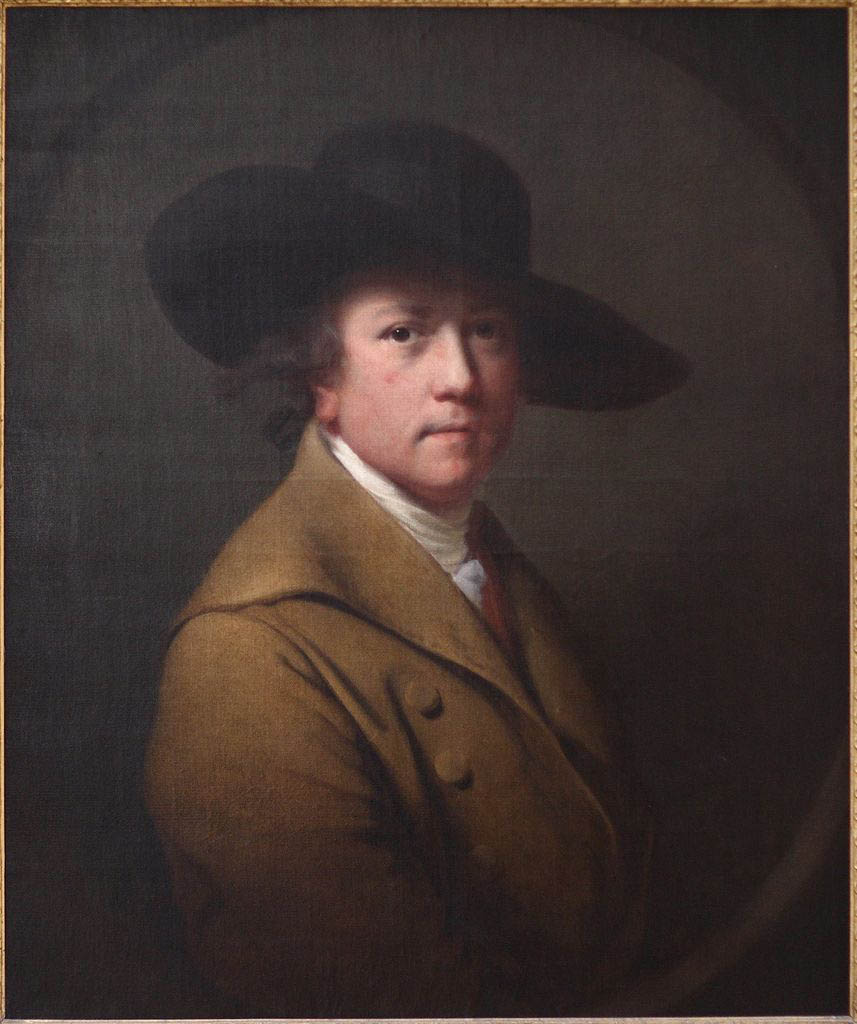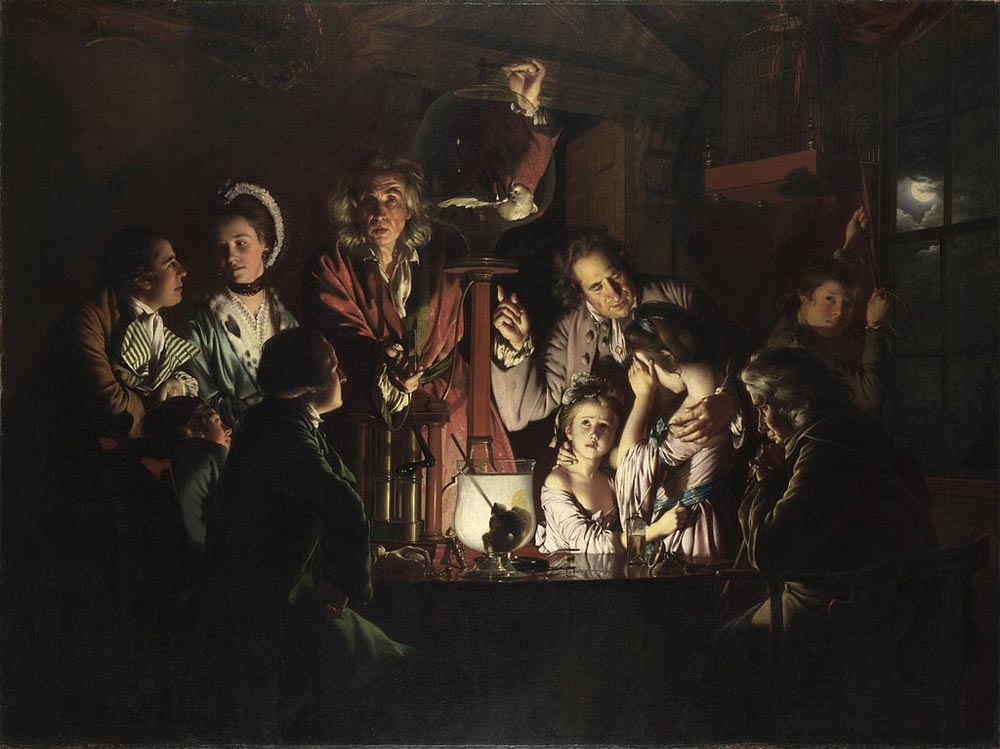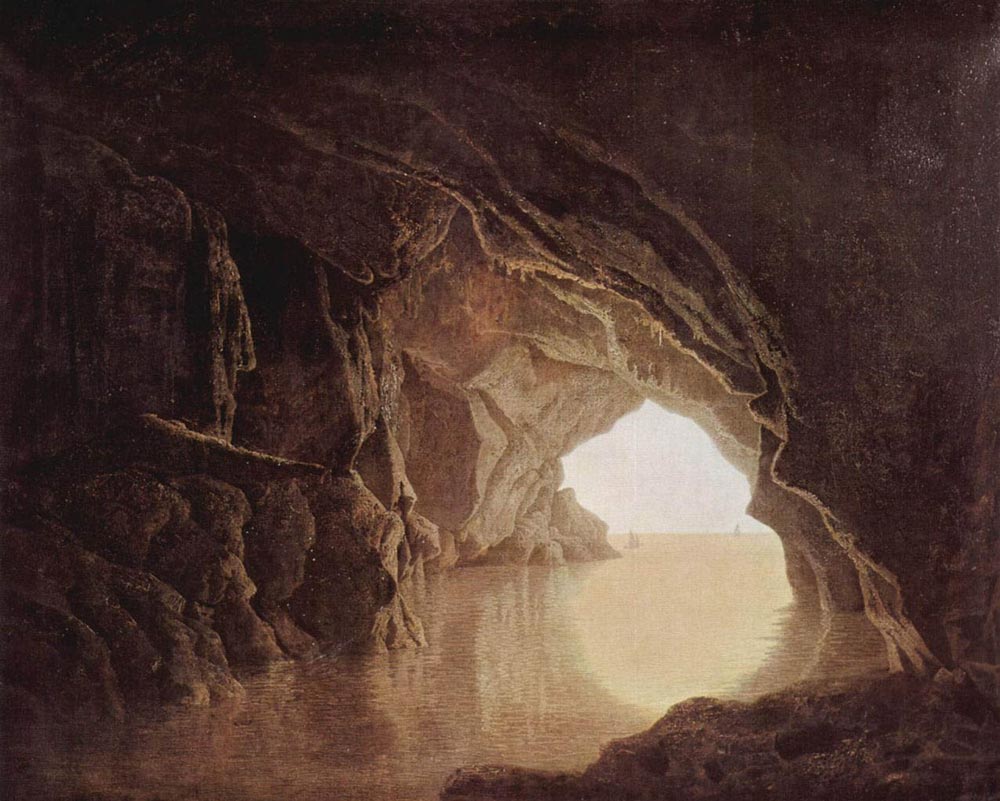| Joseph Wright | |
|---|---|
 |
|
| Born | Sep. 3, 1734 |
| Died | Aug. 29, 1797 (at age 62) |
| Nationality | English |
| Field | Painting |
| Works | View Complete Works Three Gentlemen observing the ‘Gladiator’, 1765 A Philosopher Lecturing on the Orrery, 1766 An Experiment on a Bird in the Air Pump, 1768 |
Joseph Wright (1734-1797), an English landscape and portrait painter, was commonly called Wright of Derby, because he resided in Derby, England. Wright was the first artist to capture the awe and wonder inspired by inventions and technology of the Industrial Revolution. He is best known for his artistic techniques using chiaroscuro, and various lighting in his works. Joseph Wright was an artist whose style and technique challenged the somewhat rigidly formulated painting genres. Wright incorporated a number of art genres into his works, and cast a glow into future artistic styles.
Timeline Of Experience
Joseph was born in Irongate, Derby, in the Midlands of England, and was the third of five children. Joseph enjoyed copying prints, and eventually taught himself to draw from imitation. He was educated at Derby Free Grammar School, and in 1751, studied with the portraitist Thomas Hudson in London, becoming his assistant. In 1753, Joseph returned to Derby and painted portraits, with his developed technique of chiaroscuro, or prominent contrasts.
In 1756, Wright returned to Hudson’s studio, and then moved to Liverpool in 1768, painting portraits of the more prominent citizens and their family members. He married in 1773 and went to Italy, where an eruption of Mount Vesuvius inspired a number of paintings. Wright returned to his home in Derby, as there was no interest in his portraits in Italy. He then began painting portraits of mill owners and industrialists of the time in Derby.
Joseph and his wife had six children, and tragically, three of whom died in infancy. He was asthmatic, and as time progressed, his condition worsened. Although his portraits of people were admired in England, Wright was more recognized for his use of light, his contrasting technique, and portraying the Industrial Revolution through his paintings. Joseph’s wife died in 1790, and although his health was failing, he continued to paint until the year before he died, in 1797.
Revolution in Painting
 Wright had a keen interest in science and technology, and many of his friends were philosophers and scientists. Erasmus Darwin, grandfather of Charles Darwin, was his friend and physician. He also spent time with John Whitehurst, a clock and instrument maker and, Peter Burdett, a surveyor and mathematician. Two of his most prestigious patrons were Josiah Wedgewood, manufacturer of pottery, and Richard Arkwright, creator of the cotton industry factory system. Erasmus Darwin was a member of the Lunar Society, which brought leaders of industry, science, and philosophy together, and Wright occasionally either joined the group, or heard about meeting discussions from Darwin.
Wright had a keen interest in science and technology, and many of his friends were philosophers and scientists. Erasmus Darwin, grandfather of Charles Darwin, was his friend and physician. He also spent time with John Whitehurst, a clock and instrument maker and, Peter Burdett, a surveyor and mathematician. Two of his most prestigious patrons were Josiah Wedgewood, manufacturer of pottery, and Richard Arkwright, creator of the cotton industry factory system. Erasmus Darwin was a member of the Lunar Society, which brought leaders of industry, science, and philosophy together, and Wright occasionally either joined the group, or heard about meeting discussions from Darwin.
Wright’s painting A Philosopher Lecturing in the Orrery (1765) portrayed a model of the solar system, which was driven by clock-like gears. His painting An Experiment on a Bird with an Air-pump (1768) portrays the ability of air to support life. The Alchemist Discovering Phosphorus (1771), displays how a boiled-down flask of urine, containing abundant phosphorus, ignites. Some of his favored paintings were of his candlelit subjects, which include the three above, and also Old Man and Death.
Wright’s experimentation with light sources and their effects, intrigued him, as well as his viewers. He worked with both natural and artificial light sources, and also the atmosphere created by moonlight. When painting landscape scenes, he might paint the exact same scene again using different lighting, as seen in his paintings Dovedale by Moonlight, and Dovedale in Sunlight.
Wright’s fascination of light has been speculated to be based on the Enlightenment philosophy, with light depicting logic and reason, and darkness, ignorance. There were those who were seemingly enlightened, and those left in the shadows. The colors of combustion, as in his phosphorus painting, along with figures illuminated by glowing hot metals, as he painted workmen in smithies, may have been inspired by scientific lectures, or his friends in the industry and science fields.
Style, Genre, and Use of Light
Wright’s portraits are meticulously detailed, with the subject very close, and strongly illuminated. He would set the time period by including details of the time period, such as a period vase, or clothing. He painted with oils on canvas, using chiaroscuro, or using contrasts of light and dark, which was influenced by the artist Caravaggio. Wright’s paintings are realistic, melodramatic, and romantic, and while his focus initially was on portraits and landscapes, his later use of inventions as a theme, incorporated many genres. His detailed depictions of facial features, display awe, wonderment, delight, disgust, and anticipation.
These realistic, factual paintings may have had deeper meaning, such as the phosphorus igniting in front of a praying figure. It may have been signifying the somewhat difficult transition from religious beliefs into the Industrial Revolution. The facial expressions in the bird and air pump painting may indicate the concern of inhumanities which may follow the industrial age. If carefully observed, Wright’s play with lighting in the orrery painting may be used to demonstrate the various phases of the moon, such as new, half, gibbous, and full, in the faces of his subjects. His candlelit paintings also may give the impression of movement, from the flicker of candle light.
Light Still Shines
Many of Joseph Wright’s landscape paintings remained unsold during his lifetime. His portrait art, which was his primary income was respected, but not popular, and his Industrial Revolution themed paintings were ahead of their time. Joseph Wright’s genius in painting would not be truly recognized until after his death. The most extensive collection of his work is owned and housed in the Derby Museum and Art Gallery, but on loan to many other fine art museums in Europe and the United States. The Joseph Wright Centre was opened in 2005, in order to allow individuals to explore new technologies through the arts, with Joseph Wright leading the way.